

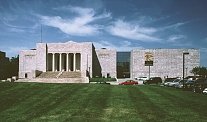
|
View from the east (with Foster addition to the right--or north)Dedicated to George Joslyn, the building faces downtown, the site of Joslyn's empire. The building is clad with Georgia Pink (Etowah Fleuri) marble--overlaying brick masonry. | |
Although the original design was a traditional Beaux-Arts classical building, even as the structure was being built, modifications transformed the museum into a "Moderne" style. Many of these changes were in architectural details. Some decoration was eliminated from the original design, other decoration transformed so that the museum is now seen as a classic of American Art Deco. (See the thunderbird capitals below.) Two architects are credited with this change: indirectly, Bertram Goodhue, the influential architect of the Nebraska State Capitol, and directly, Herschel Elarth, the design architect who was responsible for the actual decorative alterations. In addition, the sculptor, John David Brcin, a Serb born in Croatia, designed exterior sculptural decoration following a program conceived by Hartley Burr Alexander.The east portico (main entrance) and the north pair of doors (east portico) | ||
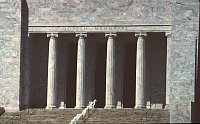
|
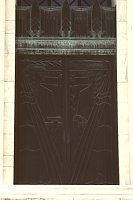
|
McDonald, Alexander, and Brcin worked out the program for the six east doors, each of which was to represent a virtue of George Joslyn. This pair represents Visio (Vision) and Spes (Hope). A lamp, representing foresight, is carried by the personified Vision while a burning torch and crystal ball are carried by Hope. |
The thunderbird capitalsInstead of Ionic capitals, the curving volutes of the Greek order are transformed into a rectilinear abstracted Native American thunderbird with extended wings. |
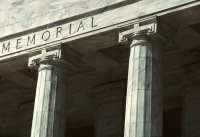
|
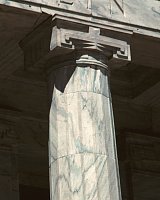
|
The south side and south entranceNote the sculptured panels at the far west top corner (left image). See the reliefs panels on the upper corners of the building by John David Brcin. Entrances on the south, north,and west facades have inscriptions honoring first, the Native Americans, then the Spanish inhabitants, and finally the prospectors and farmers. The inscription at the right reads: "In the morning of time they came / Their drums were beating / Their hearts were high / The land summoned them and they loved it." Medallions depicting the heads of Indians flank this inscription. | ||
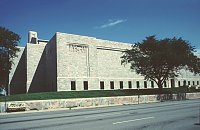
|
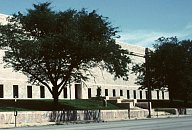
|
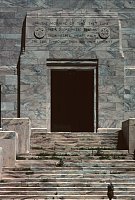
|
 Click here to return to index of art historical sites.
Click here to return to index of art historical sites.
 Click here to return to index of artists and architects.
Click here to return to index of artists and architects.
 Click here to return to chronological index.
Click here to return to chronological index.
 Click here to see the home page of Bluffton College.
Click here to see the home page of Bluffton College.
